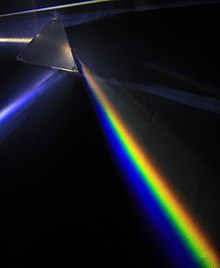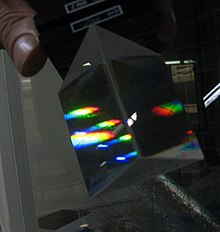
Back موشور مشتت Arabic বিচ্ছুরক প্রিজম Bengali/Bangla Dispersionsprisma German Prisma triangolare Italian Prisma dispersivo Portuguese Дисперсионная призма Russian Lăng kính tán sắc Vietnamese 三棱镜 WUU 三稜鏡 Chinese


In optics, a dispersive prism is an optical prism that is used to disperse light, that is, to separate light into its spectral components (the colors of the rainbow). Different wavelengths (colors) of light will be deflected by the prism at different angles.[1] This is a result of the prism material's index of refraction varying with wavelength (dispersion). Generally, longer wavelengths (red) undergo a smaller deviation than shorter wavelengths (blue). The dispersion of white light into colors by a prism led Sir Isaac Newton to conclude that white light consisted of a mixture of different colors.
Triangular prisms are the most common type of dispersive prism. Other types of dispersive prism exist that have more than two optical interfaces; some of them combine refraction with total internal reflection.
- ^ M. Born and E. Wolf, Principles of Optics, 7 ed. (Cambridge University, Cambridge, 1999), pp. 190–193.